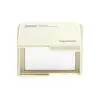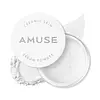What's inside
What's inside
 Key Ingredients
Key Ingredients

 Benefits
Benefits

 Concerns
Concerns

 Ingredients Side-by-side
Ingredients Side-by-side

Mica
Cosmetic ColorantSynthetic Fluorphlogopite
Silica
AbrasiveDimethicone
EmollientMacadamia Ternifolia Seed Oil
EmollientHdi/PPG/Polycaprolactone Crosspolymer
Glycerin
HumectantMagnesium Myristate
Isopropyl Palmitate
EmollientPentylene Glycol
Skin ConditioningMoringa Oleifera Seed Oil
EmollientButyrospermum Parkii Butter
Skin ConditioningEnantia Chlorantha Bark Extract
Skin ConditioningPearl Extract
AntioxidantCandida Bombicola/Glucose/Methyl Rapeseedate Ferment
AntimicrobialDiamond Powder
AbrasiveTriethoxycaprylylsilane
Polysorbate 20
EmulsifyingOctyldodecyl Stearoyl Stearate
EmollientAcrylamide/Sodium Acryloyldimethyltaurate Copolymer
Emulsion StabilisingMagnesium Aluminum Silicate
AbsorbentHydrogen Dimethicone
Sorbitan Olivate
EmulsifyingSorbitan Stearate
EmulsifyingIsohexadecane
EmollientEthylhexylglycerin
Skin ConditioningPolysorbate 80
EmulsifyingSorbitan Oleate
EmulsifyingButylene Glycol
HumectantPropylene Glycol
HumectantPolymethylsilsesquioxane
Octyldodecanol
EmollientCeramide NP
Skin ConditioningPhytosphingosine
Skin ConditioningHydrogenated Lecithin
EmulsifyingTocopherol
AntioxidantGlycine Soja Sterols
EmollientOleanolic Acid
Skin ConditioningOleyl Alcohol
EmollientPhenoxyethanol
PreservativeSodium Dehydroacetate
PreservativePotassium Sorbate
PreservativeParfum
MaskingBenzyl Alcohol
PerfumingCitronellol
PerfumingBenzyl Benzoate
AntimicrobialCoumarin
PerfumingGeraniol
PerfumingAmyl Cinnamal
PerfumingLinalool
PerfumingLimonene
PerfumingAlpha-Isomethyl Ionone
PerfumingMica, Synthetic Fluorphlogopite, Silica, Dimethicone, Macadamia Ternifolia Seed Oil, Hdi/PPG/Polycaprolactone Crosspolymer, Glycerin, Magnesium Myristate, Isopropyl Palmitate, Pentylene Glycol, Moringa Oleifera Seed Oil, Butyrospermum Parkii Butter, Enantia Chlorantha Bark Extract, Pearl Extract, Candida Bombicola/Glucose/Methyl Rapeseedate Ferment, Diamond Powder, Triethoxycaprylylsilane, Polysorbate 20, Octyldodecyl Stearoyl Stearate, Acrylamide/Sodium Acryloyldimethyltaurate Copolymer, Magnesium Aluminum Silicate, Hydrogen Dimethicone, Sorbitan Olivate, Sorbitan Stearate, Isohexadecane, Ethylhexylglycerin, Polysorbate 80, Sorbitan Oleate, Butylene Glycol, Propylene Glycol, Polymethylsilsesquioxane, Octyldodecanol, Ceramide NP, Phytosphingosine, Hydrogenated Lecithin, Tocopherol, Glycine Soja Sterols, Oleanolic Acid, Oleyl Alcohol, Phenoxyethanol, Sodium Dehydroacetate, Potassium Sorbate, Parfum, Benzyl Alcohol, Citronellol, Benzyl Benzoate, Coumarin, Geraniol, Amyl Cinnamal, Linalool, Limonene, Alpha-Isomethyl Ionone
Silica
AbrasivePolymethylsilsesquioxane
Dimethicone
EmollientDimethicone/Vinyl Dimethicone Crosspolymer
Skin ConditioningAlumina
AbrasiveVinyl Dimethicone/Methicone Silsesquioxane Crosspolymer
Caprylic/Capric Triglyceride
MaskingOctyldodecyl Stearoyl Stearate
EmollientMacadamia Ternifolia Seed Oil
EmollientSodium Hyaluronate
HumectantSimmondsia Chinensis Seed Oil
EmollientMoringa Oleifera Seed Oil
EmollientSolanum Lycopersicum Fruit Extract
AntioxidantSoluble Collagen
HumectantCaprylyl Glycol
EmollientEthylhexylglycerin
Skin ConditioningTocopherol
AntioxidantWater
Skin ConditioningGlycerin
HumectantSqualane
EmollientLinolenic Acid
CleansingCeramide NP
Skin ConditioningPhytosphingosine
Skin Conditioning1,2-Hexanediol
Skin ConditioningGlycolipids
Skin ConditioningHydrogenated Lecithin
EmulsifyingAcetyl Hexapeptide-8
HumectantCI 77492
Cosmetic ColorantSilica, Polymethylsilsesquioxane, Dimethicone, Dimethicone/Vinyl Dimethicone Crosspolymer, Alumina, Vinyl Dimethicone/Methicone Silsesquioxane Crosspolymer, Caprylic/Capric Triglyceride, Octyldodecyl Stearoyl Stearate, Macadamia Ternifolia Seed Oil, Sodium Hyaluronate, Simmondsia Chinensis Seed Oil, Moringa Oleifera Seed Oil, Solanum Lycopersicum Fruit Extract, Soluble Collagen, Caprylyl Glycol, Ethylhexylglycerin, Tocopherol, Water, Glycerin, Squalane, Linolenic Acid, Ceramide NP, Phytosphingosine, 1,2-Hexanediol, Glycolipids, Hydrogenated Lecithin, Acetyl Hexapeptide-8, CI 77492
Ingredients Explained
These ingredients are found in both products.
Ingredients higher up in an ingredient list are typically present in a larger amount.
Ceramide NP is a type of ceramide and formally known as ceramide 3.
Ceramides are intercellular lipids naturally found in our skin that bonds dead skin cells together to create a barrier. They are known for their ability to hold water and thus are a great ingredient for dry skin.
Ceramides are an important building block for our skin barrier. A stronger barrier helps the skin look more firm and hydrated. By bolstering the skin ceramides act as a barrier against irritating ingredients. This can help with inflammation as well.
If you would like to eat ceramides, sweet potatoes contain a small amount.
Read more about other common types of ceramides here:
Ceramide AP
Ceramide EOP
Dimethicone is a type of synthetic silicone created from natural materials such as quartz.
What it does:
Dimethicone comes in different viscosities:
Depending on the viscosity, dimethicone has different properties.
Ingredients lists don't always show which type is used, so we recommend reaching out to the brand if you have questions about the viscosity.
This ingredient is unlikely to cause irritation because it does not get absorbed into skin. However, people with silicone allergies should be careful about using this ingredient.
Note: Dimethicone may contribute to pilling. This is because it is not oil or water soluble, so pilling may occur when layered with products. When mixed with heavy oils in a formula, the outcome is also quite greasy.
Learn more about DimethiconeEthylhexylglycerin (we can't pronounce this either) is commonly used as a preservative and skin softener. It is derived from glyceryl.
You might see Ethylhexylglycerin often paired with other preservatives such as phenoxyethanol. Ethylhexylglycerin has been found to increase the effectiveness of these other preservatives.
Glycerin is already naturally found in your skin. It helps moisturize and protect your skin.
A study from 2016 found glycerin to be more effective as a humectant than AHAs and hyaluronic acid.
As a humectant, it helps the skin stay hydrated by pulling moisture to your skin. The low molecular weight of glycerin allows it to pull moisture into the deeper layers of your skin.
Hydrated skin improves your skin barrier; Your skin barrier helps protect against irritants and bacteria.
Glycerin has also been found to have antimicrobial and antiviral properties. Due to these properties, glycerin is often used in wound and burn treatments.
In cosmetics, glycerin is usually derived from plants such as soybean or palm. However, it can also be sourced from animals, such as tallow or animal fat.
This ingredient is organic, colorless, odorless, and non-toxic.
Glycerin is the name for this ingredient in American English. British English uses Glycerol/Glycerine.
Learn more about GlycerinHydrogenated Lecithin is created from the hydrogenation of lecithin (a group of phospholipids). Hydrogenation is a chemical reaction between hydrogen and another element.
This ingredient is an emollient and emulsifier. As an emollient, it helps soften skin by trapping moisture within. As an emulsifier, it prevents oil and water ingredients from separating.
Macadamia Ternifolia Seed Oil is the fixed oil obtained from Macadamia nut.
Macadamia seed oil is rich in fatty acids, including oleic acid (45-75%), palmitoleic acid (7-33%), and palmitic acid (6-12%). They also contain various B vitamins, iron, and magnesium.
Palmitoleic acid has been shown to help soothe inflammation and promote wound healing. It is also naturally found in the fat of our skin.
Macadamia seed oil may not be malassezia folliculitis, or fungal-acne, safe.
Learn more about Macadamia Ternifolia Seed OilMoringa Oleifera Seed Oil is the oil expressed from the seeds of Moringa oleifera plant. It is more commonly known as Moringa seed oil.
Moringa seeds have antioxidant, anti-inflammatory, and skin hydrating properties. These seeds are rich in oils, proteins, monounsaturated fats, and tocopherols.
As an emollient, moringa seed oil helps trap moisture in the skin by creating a film on top. This helps keep your skin hydrated and soft.
Many compounds in moringa seed oil are antioxidant and anti-inflammatory. These compounds include Vitamin E. , catechins, ferulic acid, and more.
Another compound found in Moringa seed oil is oleic acid.
Moringa trees are native to the Himalayan mountains.
This ingredient may not be fungal-acne safe.
Learn more about Moringa Oleifera Seed OilOctyldodecyl Stearoyl Stearate is created from stearic acid.
It is an emollient and thickens the lipid (oil) portion of a product. Due to its emollient properties, it may not be fungal-acne safe.
Phytosphingosine is a phospholipid naturally found in our skin as a building block for ceramides.. It helps moisturize, soothe, and protect skin.
Phytosphingosine contributes to your skin's natural moisturizing factor (NMF). The NMF is responsible for hydration, a strong barrier, and plasticity. Our NMF decreases with age. Increasing NMF leads to more healthy and hydrated skin.
Studies show products formulated with NMF ingredients help strengthen our skin's barrier. Having a healthy skin barrier reduces irritation and increases hydration. Our skin barrier is responsible for having plump and firm skin. It also helps protect our skin against infection, allergies, and inflammation.
Fun fact: Phytosphingosine is abundant in plants and fungi.
More ingredients that help boost collagen in skin:
Learn more about PhytosphingosinePolymethylsilsesquioxane is a silicone used as a film forming agent.
When applied to the skin, this ingredient creates an invisible film on the surface. This film still allows oxygen to pass through, but prevents moisture from escaping. This can help condition and hydrate the skin. It also leaves a silky feel when applied.
Polymethylsilsesquioxane has not been shown to clog pores. It has been deemed safe to use up to 55%, but most cosmetics use much less.
If you have concerns about using this ingredient, we recommend speaking with a professional.
Learn more about PolymethylsilsesquioxaneSilica, also known as silicon dioxide, is a naturally occurring mineral. It is used as a fine, spherical, and porous powder in cosmetics.
Though it has exfoliant properties, the function of silica varies depending on the product.
The unique structure of silica enhances the spreadability and adds smoothness, making it a great texture enhancer.
It is also used as an active carrier, emulsifier, and mattifier due to its ability to absorb excess oil.
In some products, tiny microneedles called spicules are made from silica or hydrolyzed sponge. When you rub them in, they lightly polish away dead skin layers and enhance the penetration of active ingredients.
Learn more about SilicaTocopherol (also known as Vitamin E) is a common antioxidant used to help protect the skin from free-radicals and strengthen the skin barrier. It's also fat soluble - this means our skin is great at absorbing it.
Vitamin E also helps keep your natural skin lipids healthy. Your lipid skin barrier naturally consists of lipids, ceramides, and fatty acids. Vitamin E offers extra protection for your skin’s lipid barrier, keeping your skin healthy and nourished.
Another benefit is a bit of UV protection. Vitamin E helps reduce the damage caused by UVB rays. (It should not replace your sunscreen). Combining it with Vitamin C can decrease sunburned cells and hyperpigmentation after UV exposure.
You might have noticed Vitamin E + C often paired together. This is because it is great at stabilizing Vitamin C. Using the two together helps increase the effectiveness of both ingredients.
There are often claims that Vitamin E can reduce/prevent scarring, but these claims haven't been confirmed by scientific research.
Learn more about Tocopherol